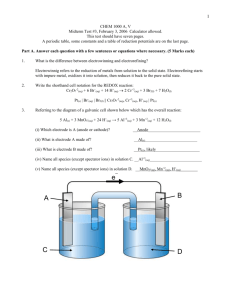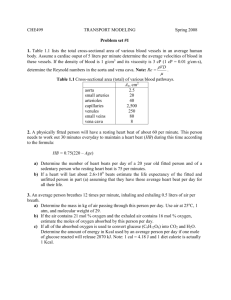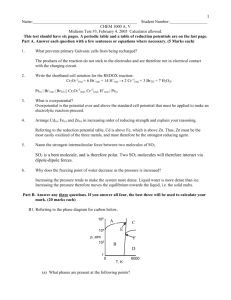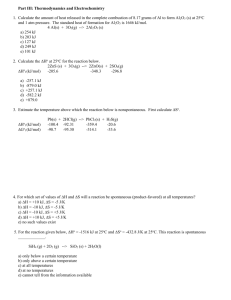quiz3-0809ans
advertisement
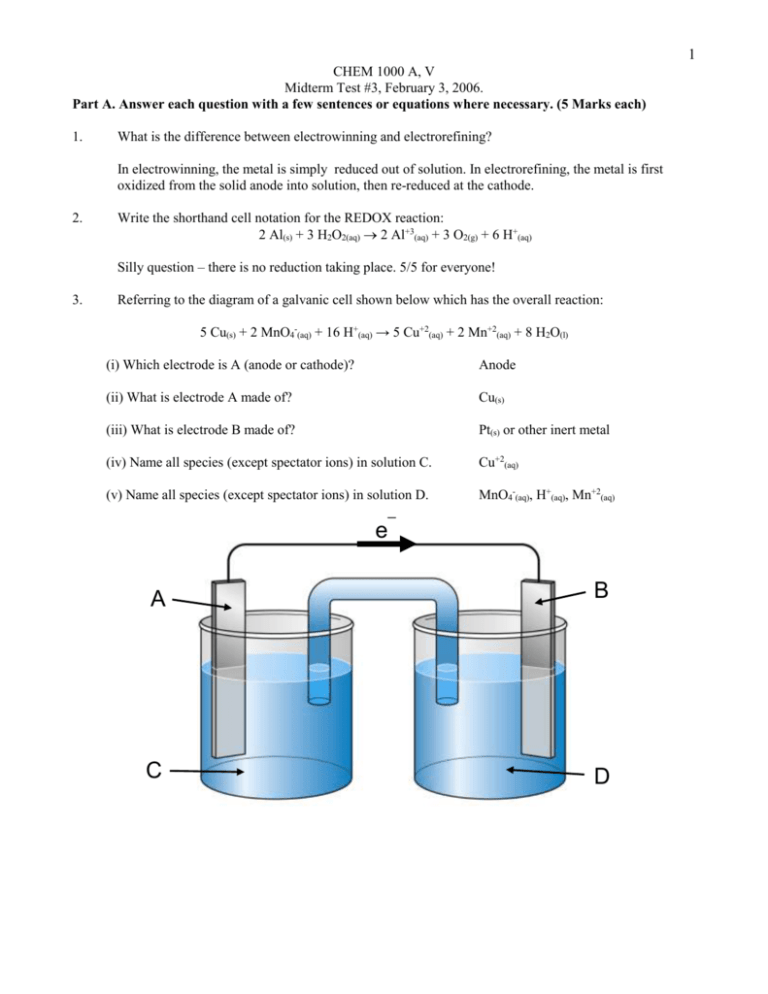
1 CHEM 1000 A, V Midterm Test #3, February 3, 2006. Part A. Answer each question with a few sentences or equations where necessary. (5 Marks each) 1. What is the difference between electrowinning and electrorefining? In electrowinning, the metal is simply reduced out of solution. In electrorefining, the metal is first oxidized from the solid anode into solution, then re-reduced at the cathode. 2. Write the shorthand cell notation for the REDOX reaction: 2 Al(s) + 3 H2O2(aq) 2 Al+3(aq) + 3 O2(g) + 6 H+(aq) Silly question – there is no reduction taking place. 5/5 for everyone! 3. Referring to the diagram of a galvanic cell shown below which has the overall reaction: 5 Cu(s) + 2 MnO4-(aq) + 16 H+(aq) → 5 Cu+2(aq) + 2 Mn+2(aq) + 8 H2O(l) (i) Which electrode is A (anode or cathode)? Anode (ii) What is electrode A made of? Cu(s) (iii) What is electrode B made of? Pt(s) or other inert metal (iv) Name all species (except spectator ions) in solution C. Cu+2(aq) (v) Name all species (except spectator ions) in solution D. MnO4-(aq), H+(aq), Mn+2(aq) e¯ A B C D 2 4. In an electrolytic cell having two Platinum electrodes and Pb(NO3)2(aq) as an electrolyte, what is produced at the anode and what is produced at the cathode? (Be careful – there are three reducible species in this solution!) At the anode: Pb+2 cannot be further oxidized. NO3-(aq) cannot be further oxidized (note that the N atom has an oxidation number of +5, which is as high as it can be) Thus, only the water can be oxidized: 2 H2O(l) O2(g) + 4 H+(aq) + 4 e¯, and so O2(g) and H+(aq) are produced at the anode. At the cathode: Pb+2 + 2 e¯ Pb(s) 2 H2O + 2 e¯ H2(g) + 2 OH¯(aq) NO3-(aq) + 4 H+(aq) + 3 e- NO(g) + 2 H2O(l) E0 = -0.13 V E0 = -0.83 V E0 = +0.96 V Reduction of the NO3-(aq) has the most positive potential, so NO(g) is produced at the cathode. 5. What is Trouton’s rule and why does it work for so many substances? Trouton’s rule states that H vap 88 J K 1 . This works because for liquids which have large Tb intermolecular forces, the boiling point will be higher. But also the enthalpy of vapourization will also be higher, and so the ratio stays about the same. Another way of looking at it is that most substances have similar entropies in the liquid phase, and in the gas phase. Thus, Svap is about the same for all substances, and at equilibrium, 6. H vap Tb Svap Referring to the phase diagram for carbon below, state which phase is the standard state of carbon. Then describe why diamonds can exist at 298 K and 1 atm. Graphite is the standard state of carbon. Although diamond is not thermodynamically stable at 298 K and 1 atm, its conversion to graphite is so slow that we cannot perceive it. 106 Diamond Liquid 104 p, atm 102 Graphite Gas 1 0 6000 T, K 3 Part B. Answer any three of four questions B1-B4. If you answer all four, the best three will be used to calculate your mark. (20 marks each) B1. The oxidation and reduction reactions in a lead acid battery are: Pb(s) + HSO4¯(aq) → PbSO4(s) + H+(aq) + 2 e¯ PbO2(s) + 3 H+(aq) + HSO4¯(aq) + 2 e¯ → PbSO4(s) + 2 H2O(l) Eo = 0.296 V Eo = 1.628 V (a) Write the overall cell reaction. [2] Pb(s) + PbO2(s) + 2 HSO4¯(aq) + 2 H+(aq) → 2 PbSO4(s) + 2 H2O(l) (b) Calculate the standard cell potential (V). [2] Eocell = 0.296 + 1.628 = +1.924 V (c) Calculate the cell potential of a fully charged battery ([H+] = [HSO4¯] = 12.0 M) on a warm day at 30oC. [8] Q 1 1 2 2 4.82 105 2 [H (aq) ] [HSO4 (aq) ] 12 12 2 RT ln(Q) nF 8.314 J K 1mol1 (303.2K) 1.924 V ln(4.82 105 ) 2(96, 487 C mol 1 ) 1.924 V (0.129 V) 2.054 V E Eo (d) Calculate the cell potential of a “dead” battery ([H+] = [HSO4¯] = 0.001 M) on a cold day at 30oC. [8] Q 1 1 1.00 1012 2 2 [H (aq) ] [HSO4 (aq) ] 0.001 0.0012 2 RT ln(Q) nF 8.314 J K 1mol1 (243.2K) 1.924 V ln(1.00 1012 ) 2(96, 487 C mol1 ) 1.924 V (0.290 V) 1.634 V E Eo 4 B2. [10] Nickel metal is being electroplated from a solution of NiCl2(aq). The cathode is a thin steel rectangle 1 m wide and 2 m high. How thick (in mm) will the nickel metal be if the solution is electrolyzed using a current of 500 A for 60 hours? Note that the metal is being plated onto both sides of the cathode simultaneously. The density of nickel metal is 8.80 g cm-3. 60 min 60s 500 Cs 1 60 h it h min n F 96487 C (mol e ) 1 1119 mol e In water, NiCl2(aq) is really Ni+2(aq) + 2 Cl (aq). Thus, the reduction reaction is Ni+2(aq) + 2 e Ni(s). The quantity of nickel reduced is therefore [5] 1mol Ni 560 mol Ni 2 mol e 560 mol Ni x 58.7 g mol-1 = 32,852 g Ni reduced 1119 mol e The total surface area of the cathode is 2 x (1 m x 2 m) = 4 m2 = 40,000 cm2 [5] 32852 g Ni 3733cm3 Ni 3 8.80 g cm 3733cm3 0.0933cm thickness 40000 cm 2 5 B3. (a) Predict which of 2-propanol or 2-propanone has the higher boiling point and explain why. O OH H3C C C CH3 H H2 2-butanol [4] C H3C C H2 CH3 2-butanone We expect 2-butanol to have the higher boiling point because of the presence of relatively strong Hbonds. In 2-butanone, there will be only relatively weaker dipole-dipole forces. (b) Now calculate the normal boiling points of 2-butanol and 2-butanone (in oC) from the following data: Enthalpy of Vaporization Hvap, kJ mol-1 Vapor Pressure at 25oC, mm Hg 2-butanol 40.8 16.1 2-butanone 34.9 90.7 The normal boiling is the temperature at which the vapour pressure is 1.00 atm (760 mm Hg). [8] For 2-butanol: T1 = 25oC = 298 K P1 = 16.1 mm Hg P2 = 760 mm Hg H vap 1 1 R T1 T2 p 1 1 ln 2 p1 T1 T2 ln(p 2 ) ln(p1 ) R H vap 1 p R T2 ln 2 T1 H vap p1 1 1 8.314 J K 1mol 1 760 ln 40800 J mol 1 16.1 298 K 389 K 1 116o C [8] For 2-butanone: T1 = 25oC = 298 K P1 = 90.7 mm Hg P2 = 760 mm Hg 1 8.314 J K 1mol1 760 T2 ln 34900 J mol 1 90.7 298 K 351 K 78o C 1 6 B4. Referring to the phase diagram below for Xenon, answer the following questions: Xenon 59.0 P, atm S 1.0 L A G 0.37 -121 -112 -108 +17 T, oC (a) [3] Label the solid, liquid and gas phase regions (S, L and G) on the diagram. (b) [1] The normal melting temperature of Xenon is: -112oC (c) [1] The normal boiling temperature of Xenon is: -108oC (d) [1] It is not possible to liquefy Xenon above 17oC (e) Explain step by step what will happen to some solid Xenon which is taken out of a freezer (at point A on the diagram) and placed on a table top at 25oC. [1] First, the solid will warm up to -112oC [3] Then some liquid will appear. Liquid and solid will be in equilibrium until all the solid has melted. The temperature will stay at -112oC during this period. [1] Then the liquid will warm up to -108oC. [3] Then some gas will appear. Liquid and gas will be in equilibrium until all the liquid has vapourized. The temperature will stay at -108oC during this period. [1] Then the gas will warm up to 25oC. (f) Is solid Xenon more or less dense than liquid Xenon? How do you know? [2] Solid Xenon is more dense. We know this because the S-L equilibrium has a positive slope. (g) Dry ice is CO2(s) in equilibrium with CO2(g) at 1 atm. Is it possible to have Xenon “dry ice” at 1 atm? Why? [1] This is not possible. At 1 atm, Xe(g) cannot be in equilibrium with Xe(s). (h) Why do you think working with liquid Xenon at 1 atm pressure is difficult in the lab? [2] This is because the liquid can only exist in a very narrow temperature range: from -112 to -108oC.
